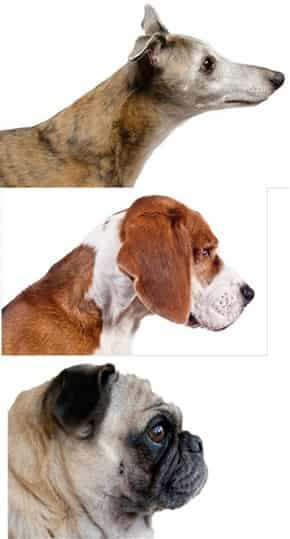Pug Dog Brachycephalic Obstructive Airway Syndrome
Overview
Unfortunately, brachycephalic obstructive airway syndrome (BOAS) is very common with Pugs. Some studies show the rate of BOAS with Pugs as being as high as 90+%; however, this does not represent the number that have this condition severe enough to require surgery.
Understanding the Brachycephalic Profile
Treatment
Since this condition involves more than one abnormality, treatment will depend on which issues a Pug has and to what extent.
Non-surgical treatment includes:
- Excess weight gain prevention/weight loss. With puppies, a plan will be put in place to prevent future issues of possible excess weight gain. With older dogs, the vet will speak to you about any excess weight that your Pug may be carrying and devise a weight loss plan, if needed.
- Immediate discontinuation of a collar. A collar will never be placed on the Pug again and a harness will be used instead, any time the dog is on leash. Harnesses are recommended at any rate for all Pugs to help prevent breathing issues. Read more about finding the right harness for a Pug.
- Limit over-excitement. Introduction or exposure to elements that would normally excite a dog should be done in a gradual way and in a low-key manner.
- Avoidance of exercise during hot, humid weather and follow exercise limitations year-round.
- A bronchodilator, as needed.
- NSAIDs (nonsteroidal anti-inflammatory drugs), which includes Rimadyl or Etogesic, may be given to help with pain and inflammation.
- Corticosteroids, which includes prednisone, may be given to help reduce pain and inflammation. This may be given via an inhaler. This is given short-term and with careful monitoring due to possible severe side effects. Even with short-term use there may be increased thirst or appetite and risk of susceptibility to infections.
- Antibiotics, to treat or prevent aspiration pneumonia.
Surgical treatment:
Corrective surgery for stenotic nares is rather straightforward and involves using a scalpel or surgical laser to remove a small piece of the wall of each nostril to widen the openings.
Corrective surgery for elongated palate is always recommended when breathing distress interferes with quality of life. This condition may worsen as a Pug matures, but if surgery can be held off until the 1-year mark it often is because if done during the puppy stage the palate may still grow and require another correction at a later date. The procedure involves using a surgical laser to shorten the palate.
Corrective surgery for hypoplastic or collapsed trachea may involve reinforcing the trachea by inserting a mesh-type sleeve and prosthetic polypropylene rings and is considered extremely high risk. All non-surgical treatment options will be attempted first.
Corrective surgery for everted laryngeal saccules involves using a laser to remove the saccules. Because everted laryngeal saccules are considered to be the first stage of laryngeal collapse (an often-fatal condition that causes a dog to suffocate) moderate to severe cases are treated in this way.
Did you find this article to be helpful?
If so, you'll appreciate having PetPugDog's GIANT Book of Pug Care which is available as both a hard copy (8.5 x 11" soft cover) and ebook (PDF).
Stay Informed:
Become a free PetPugDog Member
- Receive reminders when we add new pages of information. You'll also be able to suggest a topic for us to write about; we always look to Member suggestions.
Other helpful articles:
Pug Dog Grooming
- An overview of every grooming task that needs to be done to keep a Pug clean and well-groomed.
Pug Exercise Guidelines
- How to keep your Pug active all year round without exacerbating breathing issues.
Pug Separation Anxiety
- Ways to help a Pug cope better, stay occupied, and be more relaxed when home alone.
Taking Care of a Pug's Teeth
- It's very important to keep your Pug's teeth clean and free of plaque. This can usually be accomplished at home if these tasks are done on time.
Pug Wrinkle Care
- The facial folds of this breed need to be kept clean and dry or yeast infections can develop. Read how to care for the wrinkles and treat possible issues.


